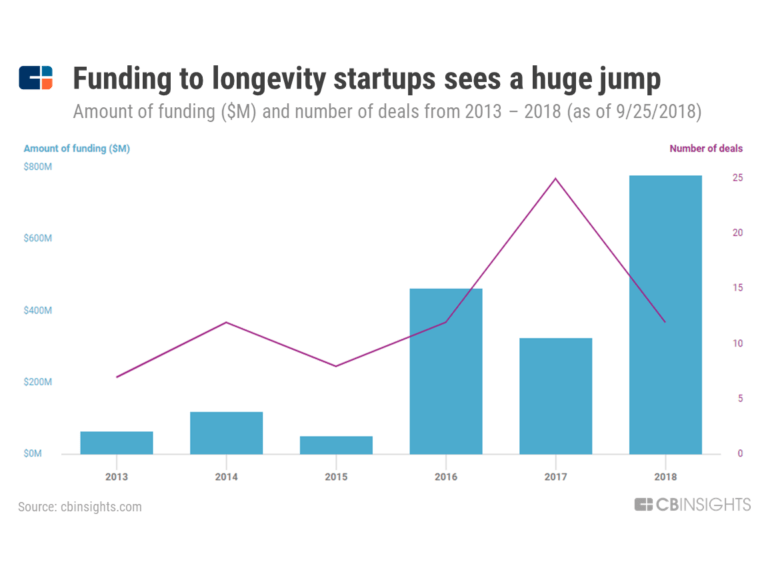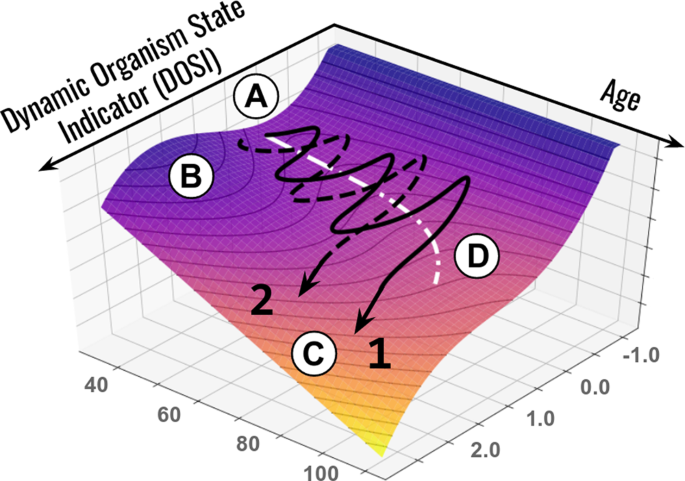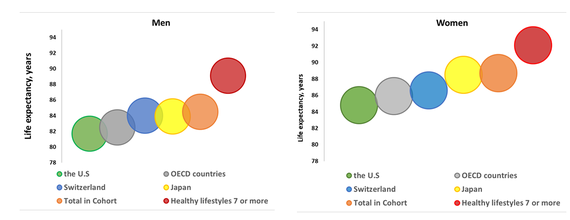Part
01
of two
Part
01
What is the state of research into slowing down the aging process?
Key Takeaways
- STAT Longevity Report notes that recent years mark the beginning of a new era for research on treatments to slow down aging, with multiple ongoing clinical trials testing "the idea that some drugs, by altering the trajectory of fundamental processes inside cells, may delay or even prevent the onset of many diseases of old age."
- The growth of anti-aging research accelerated significantly in 2013, resulting in many breakthroughs between 2013 and 2022. Key directions include "senolytics discovery, drug repurposing, stem cells, genomics, and discovery of biomarkers of aging (‘aging clocks’)."
- In late 2020, researchers from Harvard Medical School managed to turn adult cells to stem cells by using a "harmless virus." In their experiment, old mice with "damaged retinas and poor eyesight" had their vision significantly improved, sometimes to the point where they could see better than their children.
Introduction
The report presents the overall focus of research into therapies to slow down aging, including major directions in the last decade and prioritizing the number of years lived in good health as opposed to the longer lifespan. It also provides more specific areas of focus, including aging hallmarks and indications. Additionally, it includes two recent breakthroughs, i.e., Japanese scientists developing a vaccine that targets senescent cells and US researchers successfully reprogramming cells while preserving their identity in mice. Finally, it discusses selected drivers of longevity research, such as the use of emerging technologies and increased funding, as well as barriers, which are uneven distribution of funding for early-stage projects, confusion around what this type of research involves, and unfeasibility of clinical trials that target a longer lifespan.
The Research Strategy section includes clarifications on the terms and sources used in the report.
Research Into Anti-Aging Treatments
Overall Focus
- Contrary to popular conceptions, the main focus of longevity research is not increasing the lifespan but the healthspan, i.e., how long people can live with no diseases. Jim Mellon, chairman of Juvenescence, a longevity business, notes that a treatment capable of adding one to two years to the healthspan would bring trillions of dollars in global economic benefit, factoring in improved productivity and healthcare-related savings.
- STAT Longevity Report notes that recent years mark the beginning of a new era for research on treatments to slow down aging, with multiple ongoing clinical trials testing "the idea that some drugs, by altering the trajectory of fundamental processes inside cells, may delay or even prevent the onset of many diseases of old age."
- The growth of anti-aging research accelerated significantly in 2013, resulting in many breakthroughs between 2013 and 2022. Key directions include "senolytics discovery, drug repurposing, stem cells, genomics, and discovery of biomarkers of aging (‘aging clocks’)."
- Eric Verdin, CEO of the Buck Institute for Research on Aging, believes that the current knowledge could soon be possible to help people live up to 95 in good health, even though everyone is "only talking about how we are going to get the tech guys to live to 150," which he considers significantly less urgent.
Research Focus in Terms of Aging Hallmark and Indication
- Despite the recent boom in longevity research, none of the treatments in the field have been approved yet, with the first approvals expected no sooner than in 2026.
- Still, longevity research grew significantly between 2011 and 2021. According to Longevity Technology, 2057 papers were published on the topic in 2011, compared to 3991 in 2022. The number of clinical trials by longevity companies went up from 37 to 45.
- These clinical trials can be broken by the aging hallmark they target. 36% of them focus on mitochondrial dysfunction, suggesting that it is among the leading areas of research into treatments to slow down the aging process.
- According to scientists from the Buck Institute for the Research on Aging, the malfunction of the mitochondria of cells occurs in most age-related diseases. They believe that the issue is likely connected to aging in general, stressing that mitochondria play a crucial role in processes such as immune response, metabolism, and inflammation.
- Other areas of focus for clinical trials include stem cell exhaustion (15%), loss of proteostasis (15%), telomere attrition (8%), genomic instability (8%), and senescence (8%).
- In terms of indication, as of 2021, active clinical trials by longevity companies focused on age-related macular degeneration, dementia, obesity, non-alcoholic steatohepatitis, Parkinson's, spinal muscular atrophy, sarcopenia, osteoarthritis, aging frailty, degenerative disc disease, Leber hereditary optic neuropathy, and dry eye disease.
- It is important to note that reports differ in what they classify as aging research clinical trials. The report by Aging Analytics factors in both age-associated disease and longevity clinical trials, which provides a different breakdown by category. However, as seen in the chart below, longevity-focused clinical trials account for about 20%.
- For reference, the regularly updated list of longevity clinical trials is available here.
Recent Discoveries
A Vaccine That Targets Senescent Cells
- In 2021, Japanese scientists achieved a breakthrough in their research into removing senescent cells, i.e., aging cells that can't replicate but, if accumulated, can result in chronic inflammation or disease. They are involved in most age-related diseases and, depending on the place of accumulation, may cause diabetes, heart failure, or other diseases.
- While the role of senescent cells in aging has been studied since 2011, early drugs were not effective in only targeting those "zombie cells," which are neither dead nor alive. They caused serious side effects, as they also killed healthy cells. Similarly, the Tokyo-based group of researchers was initially unsuccessful in identifying the right markers.
- However, in 2021, they identified a protein on the surface of senescent cells, which is so scarce in other types of cells that it can be safely targeted. The discovery served as a basis for developing a vaccine and demonstrating that the immune system can get rid of aging cells with this kind of treatment.
- When used on prematurely aging mice, the vaccine improved the lifespan by 19% while also reducing frailty and metabolic disease.
- The discovery is in the nascent phase and will not be tested on humans for many years. However, the researchers emphasize that other senolytics are already in clinical trials, with the approval of at least one drug from the category expected in the next five years. The full study is available here.
Reprogramming Cells with a "Virus"
- In late 2020, researchers from Harvard Medical School managed to turn adult cells to stem cells by using a "harmless virus." In their experiment, old mice with "damaged retinas and poor eyesight" had their vision significantly improved, sometimes to the point where they could see better than their children. David Sinclair, who led the study, stated that the reversal appeared to be permanent and could be applied to other parts of the body.
- While Dr. Shinya Yamayaka had already reprogrammed human adult cells in 2007 to make them act like stem cells and received a Nobel Prize for his discovery, the reprogrammed cells didn't preserve their identity. Still, his work was an important breakthrough with 'his induced pluripotent stem cells, soon becoming known as Yamanaka factors."
- Further research by scientists from the Salk Institute for Biological Studies led to reprogramming cells without impacting their identity in 2016. However, there was a side effect of some mice developing cancerous tumors.
- Sinclair and his team focused on three out of four Yamanaka factors, unlike the Salk Institute, to increase safety. They were genetically added to a "harmless virus," which was later injected into each mouse's eye. However, researchers noted that the three factors could likely also be delivered in a different form.
- The studies are in the early stages. According to Sinclair, it will be years before clinical trials conclude and such treatment receives FDA approval, with no specific estimation provided. The full study is available here.
Drivers
- Increased adoption of artificial intelligence (AI) and machine learning (ML) is one of the primary drivers of aging research, significantly speeding up the discovery process. According to Biopharma Trend, ML is used to discover new biomarkers, assess biological age, and construct "aging clocks" based on aging phenotypes, as opposed to time.
- AI platforms are used to "enhance the target identification and prioritization process while considering the known molecular aging pathways," as well as clinical trial design and analysis, among others.
- Furthermore, longevity research is driven by large investments, with multiple billionaires either funding existing companies in the space or starting their own initiatives. For example, in 2022, Altos Labs, an aging research initiative, raised $3 billion, with investors including Jeff Bezos, founder of Amazon. In 2021, Brian Armstrong, co-founder of Coinbase, and Blake Byers, venture capitalist, put $105 million into launching a new aging biotech company.
- It is worth noting that according to a 2018 article by CB Insights, funding for longevity companies grew significantly between 2013 and 2018. It's likely that it has been a driver since the boom started in 2013.
Barriers
- However, the investments are largely reserved for companies that are eligible for venture funding (excluding the cases where founders already have enough resources or strong VC networks to back their projects, as explained above). According to Garri Zmudze from Longevity Science Foundation, longevity research is still not fully accepted in the biomedical research space largely due to "the lack of transparent, equity-free funding for early-stage" projects.
- This branch of research also tends to be misunderstood, which contributes to the general lack of acceptance. Media sources tend to promise miracle effects that can be achieved with simple lifestyle changes, even though, in reality, it is a more complex issue "with no silver bullet that will allow humanity as a whole to live longer."
- A research paper published in the Frontiers in Aging notes that most breakthrough discoveries require significant research before it can be determined how they translate to humans. However, clinical trials in the longevity space are problematic, as it is not feasible or practical to target a longer lifespan as the primary outcome, so they always need surrogate biomarkers.
Research Strategy
We searched through academic databases (such as National Center for Biotechnology Information), industry reports (e.g., by Aging Analytics), industry media (e.g., Longevity Technology and Biopharma Trends), and other media sites (e.g., CNN). For recent discoveries, we partially relied on media accounts as opposed to original publications, as they included additional context with statements from researchers and comparisons to previous discoveries in the space. However, we highlighted links to the studies in the appropriate sections.
The report uses one dated source (a 2018 article by CB Insights). However, it is only used to provide additional context around a recent driver.






